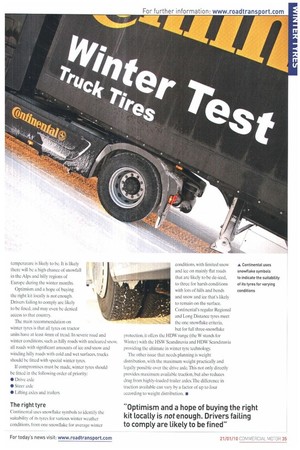COMMON-SENSE ADVICE If you're looking for advice on winter driving
Page 34

Page 35

If you've noticed an error in this article please click here to report it so we can fix it.
without necessarily leaving the UK, the Bad Weather Driving Guide has recently been published by Freight Best Practice Scotland and the Scottish government. Although little more than a summary of common-sense advice, there's always scope for the best of us to have our memory jogged. Available as a free download, there's no reason for any driver not to have their own copy: go to www.freightbestpractice.org.uk/scatland. temperature is likely to be. It is likely there will be a high chance of snowfall in the Alps and hilly regions of Europe during the winter months.
Optimism and a hope of buying the right kit locally is not enough. Drivers failing to comply are likely to be fined, and may even be denied access to that country.
The main recommendation on winter tyres is that all tyres on tractor units have at least 4mm of tread. In severe road and winter conditions, such as hilly roads with uncleared snow all roads with significant amounts of ice and snow and winding hilly roads with cold and wet surfaces, trucks should be fitted with special winter tyres.
If compromises must be made, winter tyres should be fitted in the following order of priority: • Drive axle • Steer axle • Lifting axles and trailers
The right tyre
Continental uses snowflake symbols to identify the suitability of its tyres for various winter weather conditions, from one snowflake for average winter conditions, with limited snow and ice on mainly flat roads that are likely to be de-iced, to three for harsh conditions with lots of hills and bends and snow and ice that's likely to remain on the surface. Continental's regular Regional and Long Distance tyres meet the one snowflake criteria, but for full three-snowflake protection, it offers the HDW range (the W stands for Winter) with the HSW Scandinavia and HDW Scandinavia providing the ultimate in winter tyre technology.
The other issue that needs planning is weight distribution, with the maximum weight practically and legally possible over the drive axle. This not only directly provides maximum available traction, but also reduces drag from highly-loaded trailer axles. The difference in traction available can vary by a factor of up to four according to weight distribution. •




































































































































